

Every dinosaur in the Jurassic Park and Jurassic World movies — ranked
Note: This list was written before and does not include new Dominion dinos.
There’s something about dinosaurs that just takes you right back to childhood.
Both Michael Crichton and Steven Spielberg cited their own childhood fascinations with dinos as what sparked their passion for Jurassic Park. It is pretty incredible after all to think that these beasts—both the gentle giants and not so gentle giants—once ruled the Earth.
This summer’s Jurassic World: Dominion explores the tantalizing question of what it would look like if humans and dinosaurs inhabited the Earth together. Sort of a 21st century One Million Years B.C., if you will.
A whole lot of dino species have popped up throughout the five Jurassic films so far, and Dominion is set to introduce more unseen dino species than ever before. They’ve all been pretty rad, to be honest—they’re dinosaurs, how can they not be?!—but as always, some are fan favorites, some cool cameos, and some barely on screen long enough to make an impression.
Where did your favorite dino wind up on this perfectly objective ranking of the Jurassic dinosaurs? That’s what we’re about to find out.
I’d warn you not to move a muscle but you’ll need those to scroll. So just don’t go lighting any flares. Seriously. Especially if you’re indoors. That’s actually probably never a good idea.
So I’ll just say hold onto your butts as we embark on the ultimate ranking of every dinosaur in the Jurassic Park and Jurassic World movies.
26. Ceratosaurus
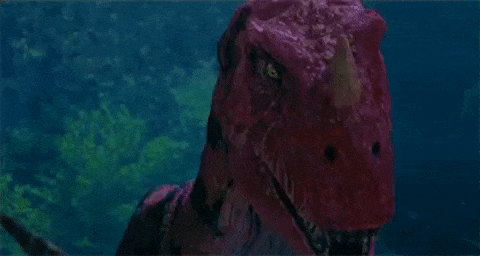
In the first Jurassic Park, Grant calms Lex by telling her the brachiosaurus is kind of a big cow. If they had encountered a ceratosaurus instead, he might have said, “Just think of it as a big, pink unicorn that wants to devour your flesh.” Grant’s good with kids that way.
Luckily for the intrepid heroes of Jurassic Park III who are the first to encounter one, they happen to be surrounded by spinosaurus poop, and if you smell like spinosaurus poop you basically are a spinosaurus yourself. Small blessings everywhere.
The ceratosaurus blinks twice, makes a disapproving noise, and wanders off (similar to my own reaction after watching JPIII for the first time). All in all, a memorable if not exactly spectacular JP debut.
25. Corythosaurus
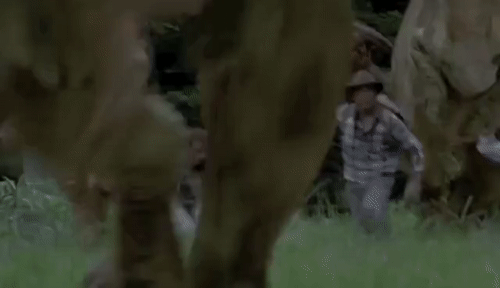
Another dino that’s unique to JPIII, the corythosaurs get their big moment in the spotlight when a raptor pack drives them into a stampede along with some grazing parasaurs. While I’m sur
e the corythosaurus was a perfectly lovely animal in person, in the film they’re little more than orange blurs for the human cast to weave between.
24. Allosaurus
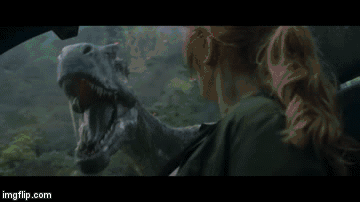
In a blink-and-you’ll-miss-it cameo during Fallen Kingdom’s big stampede, a juvenile allosaurus pulls up alongside Claire’s gyrosphere to ask for directions and gets taken out by a flaming projectile from the volcano.
You gotta feel a little bad for the guy. He’s just running for his life, same as everybody else (and maybe hoping to catch a quick bite along the way).
Despite the amount of character packed into those three seconds of screen time, it’s hard to rank Allie higher than #24.
23. Dimorphodon
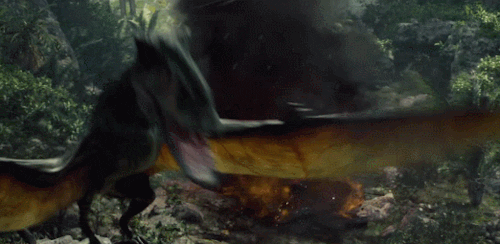
The dimorphodons turn up briefly in Jurassic World, kicking it with the pteranodons in that sweet aviary of theirs until the indominus breaks in, setting them loose to wreak havoc on the main drag.
The dimorphodons look like somebody transplanted the head of a T-rex onto the body of a baby pterodactyl, and it doesn’t help either that they behave like a bunch of hyper spazzes. But they sure are memorable.
One comes close to taking a bite out of Chris Pratt before meeting with the butt of Claire’s tranquilizer rifle.
22. Mamenchisaurus
Just why InGen would want to breed multiple species of sauropods when each one of these majestic animals would go through 160 tons of food a year and produce a commensurate amount of waste is anyone’s guess, but in The Lost World the brachiosaurus was replaced by mamenchisaurus as the longest neck in town.
The mamenchisaur’s size is put on full display when one of Ludlow’s men races between its legs on a motorbike like a snow speeder through the legs of an AT-AT. For a dino with such little screen time, the mamenchisaur admittedly makes a very cool entrance.
21. Sinoceratops
The Swiss cheese of ceratopsids, the ‘90s jeans of horned herbivores, sinoceratops is basically a triceratops with holes in its headgear.
While not nearly as iconic as its three-horned cousins, sinoceratops has definitely got spunk. In Fallen Kingdom, one takes on a full-grown carnotaur in the midst of a volcanic explosion. It just flips the brute like a side of bacon and goes on its way.
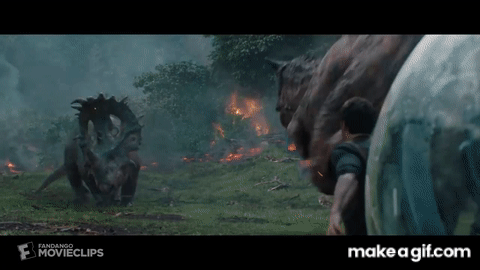
The perfect embodiment of nonchalance, sinoceratops is the honey badger of the dinosaur kingdom. Salivating carnotaur at your 9 o’clock? Sinoceratops don’t care.
20. Apatosaurus
The apatosaurs most notably appear as a slaughtered herd that fell victim to the rampaging indominus in Jurassic World.
One even gives Titanic’s Jack and Rose a run for their money when it expires in Chris Pratt’s arms to slow piano. This just might be the hardest the death of an animatronic has ever hit.
Still, for all the pathos to be found in that field of death, the apatosaurs’ top moment has to go to the baby in the petting zoo that just looks overjoyed to be getting a hug. Either that or it can’t breathe.
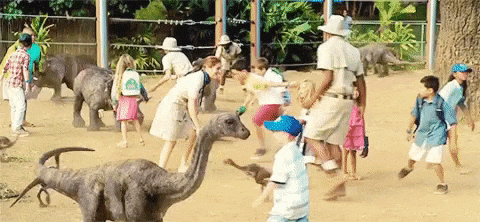
(How is that petting zoo not a gigantic stack of lawsuits waiting to happen anyway?)
19. Carnotaurus
The cinematic debut of the carnotaurus was long anticipated by fans after it first appeared in Crichton’s 1995 novel sequel, The Lost World, where it had the ability to camouflage and was feared even by the raptors.
The camouflaging attribute was given to the indominus in Jurassic World, depriving the carnotaurs of one of their cooler features, and they weren’t given a whole lot to do when they did finally turn up in Fallen Kingdom. In fact, they mostly just got whomped on by the T-rex. But though underused, the bull-horned predator still made a chilling impression.
18. Spinosaurus
On paper, the idea of a 50-foot apex predator with a visually impressive back sail and terrifyingly long crocodile jaws sounds like one of the coolest ideas for a JP dino, and indeed Spinosaurus aegyptiacus was intended to replace T-rex as the biggest and baddest dino around.
But you know what they say about the best-laid plans...
Having the spino totally trash everybody’s favorite non-human character was clearly not the way to endear fans. The uneasy blending of animatronics with CGI had the further effect of making JPIII’s star attraction come off a bit goofy-looking in scenes where it’s meant to be terrifying.
Spinosaurus is still a great candidate for future entries in the JP franchise and it may one day get its due, but for now, it’s probably most fondly remembered for being the skeleton the T-rex triumphantly smashes through on its way to take down the indominus in Jurassic World.
17. Gallimimus
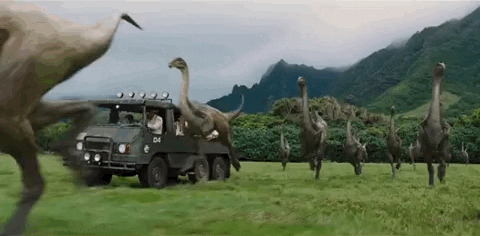
With dinos that can camouflage, fling venom, or obliterate jeeps with any manner of naturally growing body armor, there’s nothing that particularly stands out about the humble gallimimus.
The ostrich-like omnivores do however feature in one of the most memorable and stunning sequences in Jurassic Park when a whole herd of them flock toward Grant, Lex, and Tim and run afoul of the T-rex hiding in the trees.
It’s the first time we were really shown the scale of what CGI could accomplish in one of these films. It’s one thing to show a lone brachiosaur munching on some trees or a tyrannosaur exiting its paddock, but to portray a whole herd of squawking and stampeding dinosaurs with human characters moving within their midst was something else entirely.
For the sheer movie magic of it all, the gallimimus flock will always hold a special place in my heart.
16. Indoraptor
Following Jurassic World’s body count-stacking Indominus rex, something always felt a bit 2.0 about the indoraptor in Fallen Kingdom. Another lab-cooked hybrid superpredator in place of a real dino that hadn’t been featured yet? Seemed like a bit of been there, done that. But the indoraptor proved to be more than a rehash.
It’s actually pretty cool how Fallen Kingdom’s main antagonist harks back to the classic Universal monsters: first Frankensteined to life in the dungeon of a creepy old manor, then found lurking under a full moon like the wolf man and invading a bedchamber through the window like a prehistoric Dracula.
Points have to be docked for behaving a bit too human at times (such as the Bugs Bunny games it plays with Wheatley in its holding cell), but for the most part, the indoraptor was a devilishly designed and chillingly ruthless new killing machine. Its battle with Blue inside the house and across the rooftop is one for the ages.
15. Parasaurolophus
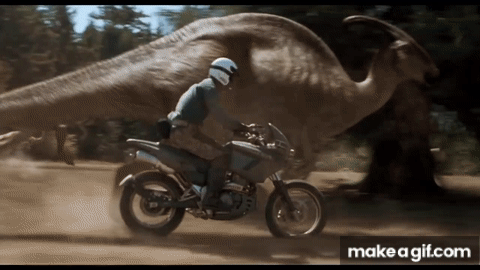
The parasaurolophus has a long history in the Jurassic Park franchise. Alongside brachiosaurus, they’re the first dinosaur to be fully seen in the original, and they’re one of the few species to have appeared in all six films so far (the other three being triceratops, velociraptor, and T-rex).
True, they have never really had a standout scene of their own. They feature most prominently in the roundup scene of The Lost World, where they’re dubbed “Elvis” by a frustrated Roland Tembo on account of their backward-swooping head crests. But the parasaurs are majestic-looking animals nevertheless and an undeniably iconic part of Jurassic Park’s dino lineup.
14. Ankylosaurus
Ankylosaurs are very much the giant turtles of the prehistoric world, except instead of being able to hide inside their shells they have 50-lb. tail clubs that can shatter the shinbones of a T- rex.
So in that sense, they’re kind of more like tanks that run on plants.
It took a cool minute for the ankylosaurs to make their way into the films. They cropped up as part of the scenery in JPIII before director Colin Trevorrow, who cited the armored herbivores as his favorite, gave them some truly awesome action in Jurassic World.
When Zach and Gray go off-roading in their gyrosphere, they get caught up in a battle between the indominus and four grazing ankylosaurs. We’re put right smack in the middle of the action as their gyrosphere bounces back and forth between the panicking ankies, and we see what damage those tail clubs can really do.
13. Pachycephalosaurus
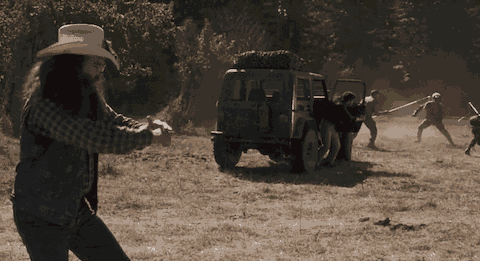
Part of me is disappointed that I’ve never come across a cartoon where one pachycephalosaurus says to another, “Just use your head,” but no part of me is disappointed these awesome dome-butting dinosaurs became part of the Jurassic universe in The Lost World.
While the Robert Bakker lookalike, Robert Burke, explains the mechanics of how the pachy’s neck aligns with its backbone to absorb the impact of a blow from its 9-inch-thick head dome, like he’s in some kind of a lecture hall, one of the pursued pachies smashes in a jeep door, hurtling a cowering hunter clear through the vehicle and out the other side.
Oh, they got cattle prods and lassos? Pachy don’t care. He’s gonna head-butt his way right outta there.
I know I already used the honey badger comparison for sinoceratops, but screw it, the dinosaur kingdom can have two honey badgers.
12. Stygimoloch
Or three?
It really is splitting hairs to distinguish between the pachy and the stygi here. They’re practically the same dinosaur. In fact, paleontologist Jack Horner believes the stygimoloch specimens that have been found are really just juvenile pachycephalosaurs and that the elongated spikes at the base of their skulls would recede with age.
Whatever the case may be, the stygimoloch that shares a jail cell next to Owen and Claire in Fallen Kingdom is a real hoot and just edges out the pachy for the larger role it plays.
After Owen riles the animal up in order to get it to head-smash them an exit, the stygimoloch stumbles into a dinosaur auction where it proceeds to wreak havoc on its captors and the assembled buyers in a beautiful representation of Jurassic Park’s core message: “Don’t mess with nature or nature will mess with you.”
Word.
11. Triceratops
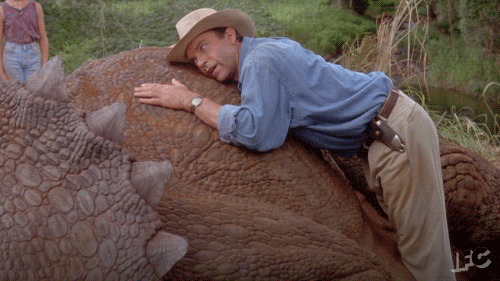
Fun fact: the sick, West Indian Lilac berry-eating dino the JP tour group comes across was actually a stegosaurus in the book, but Spielberg changed it to a triceratops because that was his childhood favorite.
He made the right choice too. The triceratops is just one of those beloved dinosaurs everyone instantly recognizes by its three horns and classic neck frill. The very sight of the animal fills you with childlike wonder.
The animatronic Stan Winston built also happened to be among his very best work. When Sam Neill leans against the animal’s pebbly hide and listens to it inhale you know that triceratops is real.
If there’s any doubt still lingering in your mind just read this for confirmation: Spielberg accused of hunting triceratops for sport.
10. Stegosaurus
After swapping the stego out for triceratops in the first one, Spielberg felt compelled to put it in the sequel, especially after fan mail poured in from children begging to see it. As it turned out, The Lost World was a much more exciting debut for the spiky-tail herbivore.
When Malcolm, Eddie, and Nick catch up with Sarah Harding on Isla Sorna, she’s setting out to observe a stegosaur family. But as soon as she takes a picture of the baby with Nick’s camera, the autowinder starts noisily whirring and the majestic scene shifts fast as the adults take aggressive action.
Considering the danger mainly came from the carnivores in the first Jurassic Park, it was both unexpected and exciting to see herbivores turn their natural defenses on the human cast in The Lost World. These are wild animals after all. What else would you expect? The stegos move even faster than they appear capable of and swing their spiked tails like they mean business, immediately dispensing with the splendor and hurtling the viewer into a world of chaos and unpredictability.
9. Indominus rex
Jurassic World tackled the problem of having to up the ante from the T-rex by introducing the series’ first completely fictional dinosaur—a tyrannosaur/raptor hybrid that would deliver on the public’s demands for bigger, scarier, cooler, more teeth.
Of course, the public referred to here includes both the park goers in the movie and the movie’s own audiences, allowing the filmmakers to both give the people what they want and poke fun at the roles of commercialism and sensationalism in entertainment. (Let’s not forget that the animal’s full scientific name is Verizon Wireless presents the Indominus rex.)
Having learned from where JPIII went wrong, the indominus was allowed to take on the role of antagonist without comparison to or competition with the T-rex. The fact it kills for sport rather than food also helped set it apart while being a convenient way to let the animal go on rampaging from one act to the next.
In the end, giving the T-rex a chance to reclaim its title and team up with the raptors in a full-out dino battle royale cemented the indominus as the villain you love to root against.
8. Baryonyx
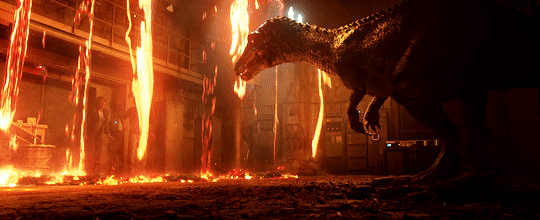
After spinosaurus stumbled out the gate in JPIII, you might have thought the filmmakers would have steered clear of using another crocodile-snouted carnivore anytime soon. Fortunately, they didn’t because the baryonyx is one of the coolest parts of Fallen Kingdom.
The baryonyx basically is a giant crocodile that moves swiftly and with agility on two legs on land and that’s small enough to follow you into confined interiors but big enough to be absolutely terrifying.
When one wanders without fanfare into the lava-flooding bunker where Claire and Franklin are trapped you almost have to laugh at the sheer improbability of it all. But that’s what makes the scene such a winner and the baryonyx one of the franchise’s best-used dinosaurs.
7. Pteranodon
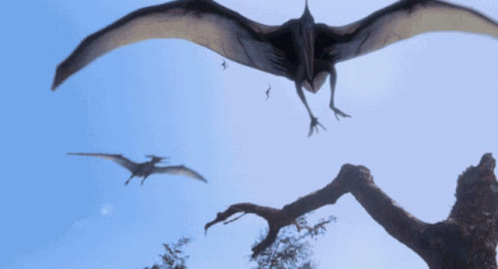
It was inevitable flying dinosaurs were eventually going to factor into the Jurassic films.
Modestly sized pterodactyls first turned up in the aviary scene in Crichton’s first book, and one was teased alighting on a branch and unfolding its wings in the closing shot of The Lost World. It may have taken CGI a second or two to reach the point of rendering realistically flying animals, but the wait for an aviary scene like the one found in Crichton’s book turned out to be oh so worth it when Jurassic Park III finally gave the pteranodons their due.
For a film that missed the mark in so many other ways, JPIII’s aviary scene is astoundingly good. The slow reveal through the mist and all the mannerisms built into the riled-up and really very dangerous pteranodons themselves add up to the best dang scene in the whole film. In fact, Jurassic World’s pteranodon breakout which finds frenzied guests running every which
way on the main drag and getting plucked up into the air is one of that film’s better scenes too. There’s no question the pteranodons have been treated well by this series.
6. Brachiosaurus
Between its very first appearance rearing up on its hind legs to reach a treetop and its swampy serenade of dinosaur-sized mooing, the brachiosaur easily became a mascot for the majestic side of Jurassic Park. They may not do much apart from munching on greens and occasionally sneezing on people who don’t like dinosaurs, but they are among Jurassic Park’s most iconic attractions nevertheless.
Fallen Kingdom director J.A. Bayona revealed that the brachiosaur seen rearing up on its hind legs with a mournful cry as it’s silhouetted through the volcanic smoke is the same one first seen by Grant, Ellie, and Malcolm. Man, between this and the apatosaurs in Jurassic World, the sauropods get it rough in these new films. Here’s hoping they pull through Dominion okay.
5. Mosasaurus
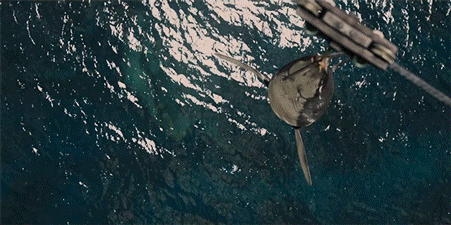
After flying dinos got their day in JPIII, it was only a matter of time before the series took to the sea and showed us what underwater dinos could do. The concept of a functioning park in Jurassic World was the perfect opportunity to include the gargantuan mosasaurus in a kind of supersized SeaWorld attraction, which comes complete with a neat Spielberg in-joke when a Great White shark is rolled out on a line for feeding time.
Between Jurassic World and Fallen Kingdom, the mosasaur has already made plenty of cool appearances—hauling down a pteranodon, the indominus, and very nearly a whole helicopter for chow time. It was last seen silently gliding after surfers in the Pacific. It will be interesting to see if and how the marine dino factors into the next one.
4. Compsognathus
The compies are just about one of the best things to happen to the JP franchise, and they couldn’t have debuted in a better film than The Lost World. They already stood out from InGen’s predominantly towering lineup with their diminutive sizes, but where the filmmakers really went right was in exaggerating the compies’ playfully skittish mannerisms.
At times, they look adorable enough to want to take home and keep for a pet, but then they’re growling like Gremlins and swarming all over you, viciously latching onto whatever they can with their tiny teeth and claws. They were the perfect new predators for The Lost World, which already had a bit of a crueler tone and more of an emphasis on black humor than its predecessor.
Much like the gallimimus herd in the first Jurassic Park, a great deal of work went into animating the CGI compies during their attack on Dieter Stark, and the result is all right there on the screen.
3. Dilophosaurus
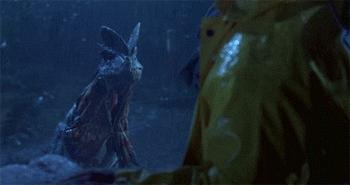
The dilophosaurus was a real wild card in Jurassic Park. Of course, everyone had their own expectations of what the T-rex would be like and the raptors’ lethal capabilities were thoroughly described by Muldoon and shown to us in brief flashes. But a dilophosaurus? What even is that?
Apart from the tour narrator casually describing the dinosaur in brief, you really have no idea what Nedry is in for when he stumbles into the animal’s rain-soaked paddock.
The shockingly colorful neck frill that flaps open and shakes as the dilo releases a horrifying growl would have been surprise enough, but then comes the blinding venom hurled in Nedry’s eyes.
The whole sequence is masterfully orchestrated and the dilophosaur superbly designed. For a dino this popular, it’s a real mystery why the spitter has never been used outside of this one scene.
But that can certainly change come Jurassic World: Dominion.
2. Velociraptor
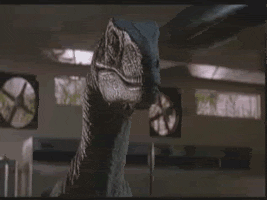
OK, so to get the obvious out of the way: yes, the real Velociraptor mongoliensis was only one and a half feet tall, which would have put them at a very convenient height to aggressively nip at Muldoon’s ankles, and as the name implies they were found in Mongolia, not the Badlands of Montana.
At the time Jurassic Park was being made, there wasn’t even a similar counterpart to Spielberg’s raptor known in the dinosaur kingdom until the discovery of utahraptor shortly before the film’s release. As is so often the case in Hollywood, sensationalism prevailed over realism and Jurassic Park’s velociraptor was about as made-up as they come.
But you know what? None of that matters. Here’s a dinosaur that was so fearsome, so iconic, and so entirely believable upon its debut in 1993 that it sank its toe claws into the hearts of audiences and rose above every one of its inaccuracies to become a deeply entrenched part of popular culture. Maybe the velociraptor never stalked the primordial forests of the Cretaceous, but it can stalk abandoned kitchens and InGen laboratories all it likes and we’ll relish every rhythmic click of that wicked toe claw.
Sure, they went through a weird phase in JPIII where they had feathers and talked to Alan Grant in his dreams. But who hasn’t gone through one of those phases?
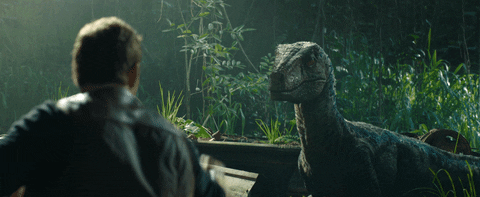
The Jurassic World films have now done the impossible and made the raptors into pseudo- heroes fighting alongside the human cast, which feels a bit like trying to make a pet out of a shark.
But they pulled it off and have left the raptors just enough of their dangerous, predatory qualities to make you wonder if they might teeter back into their untamed, primordial selves at any moment. It’s a little weird to look back at how the raptors started and think of the role they’re playing currently on the side of the guys, but any series that’s run for two decades and counting will naturally have to evolve—and the raptors have done just that.
1. Tyrannosaurus rex
The T-rex has long been the undisputed king of the dinosaurs in popular culture, and when it came to bringing one to life through CGI, animatronics, and good solid storytelling, Jurassic Park delivered on all expectations and in oh so many ways.
Not only did the T-rex come across as absolutely terrifying in its scale and its ferocity (never has a Ford Explorer taken such a thrashing on film), but the tyrannosaur also triumphantly returns to save our heroes from the raptors in the end. We can think of these dinos as animals all we want, but ultimately they’re characters too and in that sense the rex has proven to be one of the coolest, baddest antiheroes in all of cinema history.
It’s reassuring to know that the original tyrannosaur, Jurassic Park’s so-dubbed “Rexy,” is still going strong after all these years.
Here’s to Rexy’s return in Dominion and all the other species that’ll be along for the ride, old and new.
Mike Ettel is a freelance journalist who enjoys watching, reading, and writing science fiction. He’s still waiting for the day dinosaur cloning is made a reality.
Share This Article
Read Next

10 music videos that homage classic horror cinema
By Guest Contributor | November 17, 2021
July 11 in nerd history: Celebrating a decade of Sharknado
By Classic Nerd | July 11, 2023
October 16th in nerd history
By Classic Nerd | October 16, 2023
August 23rd in nerd history: Let's call it the World Wide Web
By Classic Nerd | August 23, 2023
September 6th in nerd history: Girls just wanna (just wanna)
By Classic Nerd | September 6, 2023
November 30th in nerd history: I'll make it a true daily double
By Classic Nerd | November 30, 2023
October 31st in nerd history: You do NOT want to know what happened to Baby Jane, trust me.
By Classic Nerd | October 31, 2023
October 20th in nerd history: Take me on (take on me)
By Classic Nerd | October 20, 2023Want More Nostalgia?
Check out our other quizzes and random trivia questions!